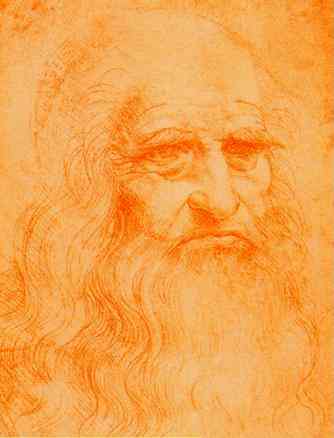
I have spent the first five posts in this “favorite artist” series indulging myself on that marvelous period in European art: the late 19th century. Now it is time to start at the beginning (in this case, the Renaissance in Florence) and work my way forward in a more logical fashion. Having made his decision, it seems appropriate to start with Leonardo, the inventor of so many things in art, as in a multitude of other fields. He is the archetype of what has come to be called “the Renaissance man”, exploring all realms of human knowledge without specialization: art, science, warfare, technology, you name it.
I will begin by showing two of Leonardo’s incredible output of drawings on every subject. The drawings on their own merits deserve to be considered part of his artistic oeuvre, though most have no artistic intention. The study of musculature – anatomy taken an extra step – has implications for artists of the human figure, but the thrust is primarily scientific. The Flying Machine simply gives a taste of the man’s unceasing technological exploration and invention.


Leonardo’s actual output of paintings is relatively small, an indication of how little he concentrated on art among his many endeavors. Yet each work produced seems to be an invention, an archetype to be picked up and developed by other artists. In the work “Madonna with Ste. Anne” Leonardo discovers the pyramidal compositional device which will be picked up and perfected by Raphael. Utterly stable, the forms gives the figures their classical timelessness and permanence. Leonardo, having developed the invention, left it pursuit to others as he so often did. Another of his inventions is the palpable smokey atmosphere, or “sfumnato” which would be picked up by later generations.


However he did use the pyramidal form in another context, in his fresco of the “Last Supper”. We see that the twelve apostles are divided up compositionally into four groups of three, each group a variation of the pyramid form. But the groups are not in self-contained isolation. Leonardo uses the form to create a ripple along the table, as Christ announces that “one of you will betray me”. The combination of stability and movement is quite ingenious. Also ingenious is the stillness of Judas, the only one to whom the announcement is not a surprise.


The other major artistic invention which can be traced to Leonardo is that of “atmosphere”, mentioned above with the “ST. Anne and the Virgin. I mean this in the root sense of a palpable thickness to the air itself, creating what in Italian is called “sfumato” (smokiness). Unlike the clear air of earlier artists, Leonardo began to introduce a haze in the background, a device which would become a staple of landscape painters for the next four centuries. This is visible in the backgrounds of both the “Annunciation” and the “Mona Lisa”. In “Mona Lisa” It even affects the foreground figure to a lesser extent, harmonizing the colors with a blue-grey cast.


This is one step away from working directly with light and shade (“chiaroscuro”) which was the invention of Caravaggio and his followers, notably Rembrandt.
Leonardo and Michelangelo, who were contemporaries in Florence, had a great rivalry as the towering figures in the arts of the city. I’ll talk a little about this in my next post, about Michelangelo.